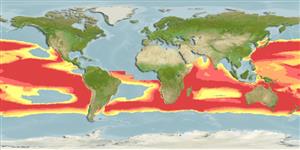Teleostei (teleosts) >
Scombriformes (Mackerels) >
Bramidae (Pomfrets)
Etymology: Pterycombus: Greek, pteron = wing, fin + Greek, kombos, oy = belt (Ref. 45335).
Eponymy: Wilhelm Karl Hartwig Peters (1815–1883) was a German zoologist and traveller who made some very important collections in Mozambique. [...] (Ref. 128868), visit book page.
More on author: Hilgendorf.
Environment: milieu / climate zone / depth range / distribution range
Ecology
Marine; pelagic-oceanic; depth range 0 - 340 m (Ref. 58302). Temperate
Southeast Atlantic. Indo-West Pacific: southwestern Africa to Japan and the central Pacific.
Size / Weight / Age
Maturity: Lm ? range ? - ? cm
Max length : 36.4 cm SL male/unsexed; (Ref. 47377); common length : 31.0 cm TL male/unsexed; (Ref. 2272)
Dorsal spines (total): 0; Dorsal soft rays (total): 46 - 55; Anal spines: 0; Anal soft rays: 37 - 40. Body color silvery-white, the membranes of the dorsal and anal fins black. Dorsal and anal fin very high, with scaly sheaths at its bases. No rays of the dorsal and anal fins thicker than their neighbors. Dorsal fin inserted above the posterior part of the eye. Attain 40 cm SL.
Juveniles probably found up to a depth of 200 m (Ref. 4388).
Life cycle and mating behavior
Maturity | Reproduction | Spawning | Eggs | Fecundity | Larvae
Gomes, J., 1990. Bramidae. p. 758-764. In J.C. Quero, J.C. Hureau, C. Karrer, A. Post and L. Saldanha (eds.) Check-list of the fishes of the eastern tropical Atlantic (CLOFETA). JNCT, Lisbon; SEI, Paris; and UNESCO, Paris. Vol. 2. (Ref. 4936)
IUCN Red List Status (Ref. 130435: Version 2024-2)
Threat to humans
Harmless
Human uses
Tools
Special reports
Download XML
Internet sources
Estimates based on models
Preferred temperature (Ref.
123201): 13.5 - 27.8, mean 22.5 °C (based on 797 cells).
Phylogenetic diversity index (Ref.
82804): PD
50 = 0.7500 [Uniqueness, from 0.5 = low to 2.0 = high].
Bayesian length-weight: a=0.01778 (0.00758 - 0.04173), b=2.96 (2.76 - 3.16), in cm total length, based on LWR estimates for this (Sub)family-body shape (Ref.
93245).
Trophic level (Ref.
69278): 4.0 ±0.6 se; based on size and trophs of closest relatives
Resilience (Ref.
120179): Medium, minimum population doubling time 1.4 - 4.4 years (Preliminary K or Fecundity.).
Fishing Vulnerability (Ref.
59153): Low to moderate vulnerability (34 of 100).
